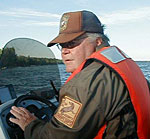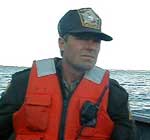On the Water
By Bob Reha, Minnesota Public Radio
July 1, 2001
The Minnesota Department of Natural Resources reported 19 boating deaths during 2000, down three from 1999. So far this year, there have been eight boating deaths. According to the DNR, the state's boating death rate continues to be one of the lowest in the nation. Part of the reason is the work by county sheriff water safety patrols.
AS THE SUN RISES over West Battle Lake, Ottertail County Water Patrol Deputies Larry Kantrud and Kelly Thomas sit in their boat, the engine idling, waiting for the shotgun start of the annual Battle Lake Walleye Tournament.
As the waves slap against the hull , the pair scan the 30-odd boats speeding off to their favorite fishing holes.
Peace returns as the engines roar into the distance. That's just how the how the water patrol likes it, and what its members are constantly working toward. "We do a lot of safety programs, talking to different property owner associations or civic groups, work with Boy Scouts once in awhile," explains Deputy Larry Kantrud, who has patrolled the lakes in Otter Tail County for 33 years.
Kantrud says the deputies take a lot of good-natured teasing about a job requiring them to ride around the area's lakes for the better part of the day. But there is a down side.
"The drownings," he says. "Dealing with them and you hope it never happens, but that's not reality."
There have already been three drownings this year in Ottertail County. That worries Kantrud because most years, three is the total for the entire year. "Some years we've gone without any and we've been thankful for those and then other years we've gone up to seven, eight, nine, 10; so it's hard to define an average year."
None of this year's victims were wearing life jackets.
"Minnesota law requires that you just have a wearable with you except on a personal watercraft. They have to have them on. You need to have the wearable with you. It doesn't say that you have to have it on; as a consequence I suppose lot of people have them with them, but when they really need them, they're not available," Kantrud says.
There are 1,000 lakes in Ottertail County. The sheriff's department has four full-time and three part-time officers to patrol those lakes. Kantrud says it forces the patrol to focus its resources. Deputies also spend a good deal of time writing permits for swimming areas and inspecting boat rental dealers.
With more than 170 rental operations in Ottertail County, that can take close to a month. Kantrud says even with seven officers to cover the entire county, most of the patrol's budget of $40,000 is spent on safety education.
"When you fall down on land you can pick yourself up; you fall down in the water, you're in trouble," Deputy Kelly Thomas says.
Mother Nature also presents hazards. This year it is high water levels. "Things wash in from shore, trees tip over, there could be dock sections out here somewhere, so you always got the safety concern someone runs into those with their boat," Kantrud says.
Kantrud says a lot of the work is public relations. Being a visible reminder to boaters to think about what they are doing, to use life jackets and most importantly to exercise common sense on the water.
By Bob Reha, Minnesota Public Radio
July 1, 2001
|
|
RealAudio |
The Minnesota Department of Natural Resources reported 19 boating deaths during 2000, down three from 1999. So far this year, there have been eight boating deaths. According to the DNR, the state's boating death rate continues to be one of the lowest in the nation. Part of the reason is the work by county sheriff water safety patrols.
| |
|
|
|
||
Peace returns as the engines roar into the distance. That's just how the how the water patrol likes it, and what its members are constantly working toward. "We do a lot of safety programs, talking to different property owner associations or civic groups, work with Boy Scouts once in awhile," explains Deputy Larry Kantrud, who has patrolled the lakes in Otter Tail County for 33 years.
Kantrud says the deputies take a lot of good-natured teasing about a job requiring them to ride around the area's lakes for the better part of the day. But there is a down side.
"The drownings," he says. "Dealing with them and you hope it never happens, but that's not reality."
There have already been three drownings this year in Ottertail County. That worries Kantrud because most years, three is the total for the entire year. "Some years we've gone without any and we've been thankful for those and then other years we've gone up to seven, eight, nine, 10; so it's hard to define an average year."
None of this year's victims were wearing life jackets.
"Minnesota law requires that you just have a wearable with you except on a personal watercraft. They have to have them on. You need to have the wearable with you. It doesn't say that you have to have it on; as a consequence I suppose lot of people have them with them, but when they really need them, they're not available," Kantrud says.
| |
|
|
|
||
With more than 170 rental operations in Ottertail County, that can take close to a month. Kantrud says even with seven officers to cover the entire county, most of the patrol's budget of $40,000 is spent on safety education.
"When you fall down on land you can pick yourself up; you fall down in the water, you're in trouble," Deputy Kelly Thomas says.
Mother Nature also presents hazards. This year it is high water levels. "Things wash in from shore, trees tip over, there could be dock sections out here somewhere, so you always got the safety concern someone runs into those with their boat," Kantrud says.
Kantrud says a lot of the work is public relations. Being a visible reminder to boaters to think about what they are doing, to use life jackets and most importantly to exercise common sense on the water.
| Previous Story: DNR cracks down on BWI |


